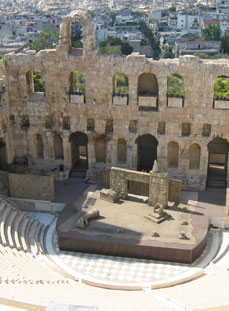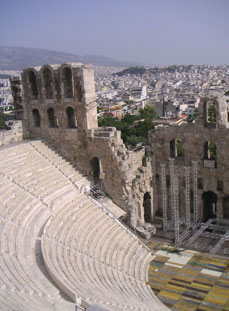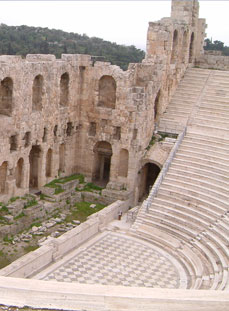


Odeon of Herodes Atticus-Herodeion
This building's exterior is visible from the sidewalk. To reach it ascend the broad stairs at the end of the archaeological park to the paved area in front of the Odeon. As the remains are closed to the public, during daylight hours, the best view of them is from above, just before one starts the ascent to the Acropolis itself. One has to enter the site of the Acropolis, however, to do this.
The wealthy benefactor of Athens, Herodes Atticus, from the prefecture of Marathon (AD 101-177), built this Odeon (or covered auditorium) in memory of his wife, Rigilla, between AD 160 and 174, according to the accounts of Philostratus and Pausanias Herodes came from a well-known Athenian family and inherited his great wealth from his father, Tiberius Claudios Atticus Herodes. During the reign of the Emperor Nerva (AD 96-98), his father discovered a huge treasure hidden in an old house in Athens, which Nerva allowed him to keep. He spent much of it on Herodes' education and on public benefactions. He was priest of Zeus Olympios and later the chief priest of the cult of the deified Emperor Trajan.
Herodes Atticus had a distinguished career in public life in Athens, but was very unpopular in the city because he preferred to spend money on buildings aggrandizing himself rather than to meet the specific needs of the Athenians. Further, he served loyally Hadrian (AD 117-138) and Antoninus Pius (AD 138161), and held the consulship in Rome in AD 143. He was the tutor of the later emperors Marcus Aurelius and Lucius Verus. In addition, he was a great orator in Greek and dabbled in literary criticism, rhetoric and sophist philosophy. When he retired to Athens from Rome, he gave money for public improvement projects and monuments, which ornamented Corinth, Olympia, Delphi and Troy as well as Athens (including the marble stadium). His wife, Rigilla, came from an important Roman family and was related to Faustina the Elder, the wife of the Emperor Antoninus Pius. She was the priestess of Demeter Chamyne at Olympia. This was the third Odeon to be built in Athens (first, of Perikles on the southeast slope of the Acropolis, and second, of Agrippa in the Agora). It was one of the last great structures built in the city before its decline and destruction. Herodes Atticus' Odeon was distinctively Roman in appearance, in contrast to the traditional Greek form of the nearby Theater of Dionysos. It was also much larger, in comparison to typical Roman odeia.
The building has is a semicircular, steeply rising cavea with a radius of 38 m, cut into the Acropolis bedrock and supported by a massive limestone wall. It is divided into two sections by a horizontal walkway (diazoma) with 20 rows of seats in the lower part and 14 in the upper. Along the rim at the top there was another diazoma, which was also of connected with the second floor of the stage (skene) building. The semicircular orchestra, is paved with marble slabs. The 4,800 seats were of white marble. The walls were reverted in marble. The stage was 35 x 8 m. The well-preserved, massively tall, wide (28 x 92 m) and thick stage wall was richly embellished with three tiers of elaborate columned architectural facades, with two doorways, and niches for eight statues. There were windows above them. Access to the Odeon was from large staircases on either side of the stage, which led to the uppermost diazoma. The east staircase connected directly to the west end of the Stoa of Eumenes II by two doorways. Mosaic floors decorated the entrances to the staircases and a long narrow vestibule situated behind the stage. The caves was covered in some fashion, without supports, by a cedar wood roof covered with terracotta tiles, according to the restoration of M. Korres.
The Odeon was destroyed by fire in the Herulian sack of the city in AD 267. In the Byzantine period the ruins appear to have been used for manufacturing Tyrian purple, a dye extracted from Murex trunculus shells.
The Odeon, which was excavated between 1848 and 1858, was restored to a certain extent in the 1950's. It is now used for the evening performances of the Athens Festival and other artistic productions. One should make an effort to attend at least one performance here, in order to experience the multi-dimensional feel of this unusual performance space!
It is interesting to note here that in the 1880s, when discussions were held as to where the National Archaeological Museum should be built, one of the proposed locations was the open ground immediately to the south of the Odeon. In 1887 Theophilus Hansen made plans and drawings for a vast and elaborate museum here. This project, as with most projects relating to the development of the cultural heritage of the city over the past 170 years, was not realized.
